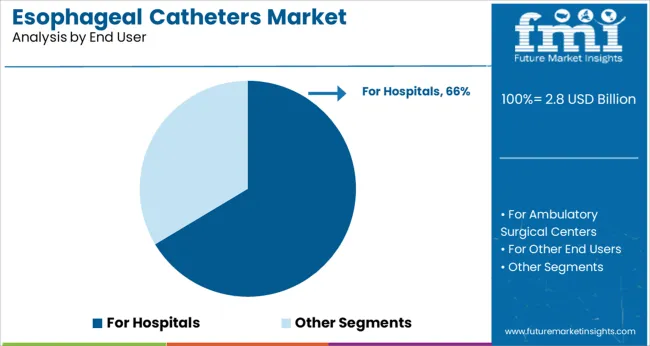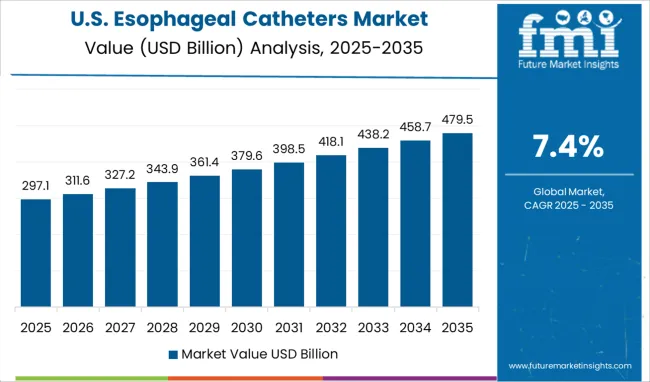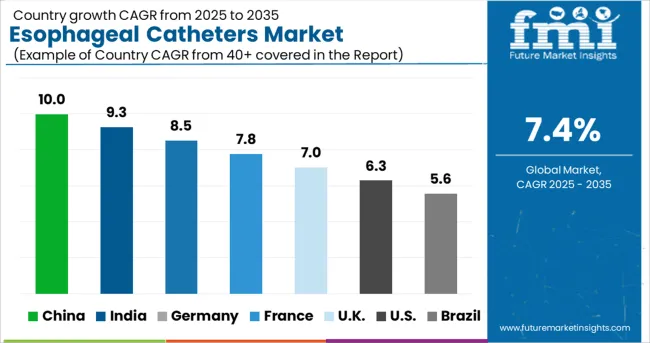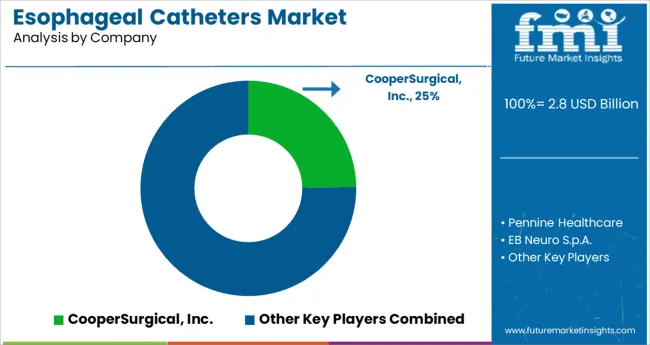The Esophageal Catheters Market is estimated to be valued at USD 2.8 billion in 2025 and is projected to reach USD 5.7 billion by 2035, registering a compound annual growth rate (CAGR) of 7.4% over the forecast period.

The intrasaccular embolization systems market is witnessing steady growth as minimally invasive treatments for intracranial aneurysms gain traction. The increasing preference for less invasive neurological procedures has driven adoption of embolization systems that effectively prevent aneurysm rupture. Advances in device design have improved safety and procedural success rates, encouraging more hospitals to integrate these systems into their neurointerventional suites.
Growth is further supported by the rising prevalence of aneurysms due to aging populations and increased diagnostic capabilities enabling early detection. Regulatory frameworks and clinical guidelines emphasizing patient safety and procedural efficacy have also promoted wider use.
Future growth is expected to be driven by continued technological innovations and expanding treatment indications. The market is poised for expansion, with significant demand from hospitals providing neurovascular care.
The market is segmented by Product Type and End User and region. By Product Type, the market is divided into Balloon Dilation Esophageal Catheter, Irrigation Esophageal Catheter, and Pressure Monitoring Esophageal Catheter. In terms of End User, the market is classified into For Hospitals, For Ambulatory Surgical Centers, and For Other End Users. Regionally, the market is classified into North America, Latin America, Western Europe, Eastern Europe, Balkan & Baltic Countries, Russia & Belarus, Central Asia, East Asia, South Asia & Pacific, and the Middle East & Africa.
The Intrasaccular Embolic Coils segment is projected to hold 45.8% of the market revenue in 2025, maintaining its dominance as the preferred product type. This segment’s growth is attributed to the coils’ effectiveness in occluding aneurysms by filling the sac with minimal disruption to blood flow. The design improvements have increased coil flexibility and deployment precision, resulting in higher treatment success rates.
Their minimally invasive nature reduces recovery times and hospital stays, making them favorable among clinicians and patients alike. The coils’ compatibility with various catheter systems and their ability to treat a broad range of aneurysm sizes have expanded their applicability.
These factors contribute to the sustained leadership of the Intrasaccular Embolic Coils segment.

The Hospitals segment accounts for 66% of the market revenue in 2025, reflecting its dominant role as the primary end user of intrasaccular embolization systems. Hospitals are the main providers of neurovascular interventions requiring these devices, supported by their access to specialized clinical teams and advanced imaging technologies.
The growing number of neurointerventional centers and the expansion of hospital-based treatment programs have increased demand. Hospitals prioritize acquiring proven embolization systems that enhance procedural safety and outcomes.
Additionally, increasing awareness of minimally invasive aneurysm treatments among referring physicians and patients has driven hospital volumes. As infrastructure and expertise in neurovascular care grow globally, hospital demand for these systems is expected to continue rising.
The major factor that is expected to drive the growth of Esophageal Catheters Market during the forecast period includes the growing prevalence of chronic esophageal disorders and raising R&D activities.
Moreover, growing surgical procedures number, increasing healthcare awareness and growing demand for minimally invasive surgeries are some other factors that are expected to accelerate the growth of the Esophageal Catheters Market during the forecast period.
Additionally, technological advancements and growing elderly populace as they are more prone to many chronic diseases are other major factors that are expected to favor the growth of esophageal catheters market globally.
The major factor that is expected to hamper the growth of the Esophageal Catheters Market during the forecast period includes stringent regulatory approvals.
Moreover, some other factors that are expected to hinder the market growth include poor availability of esophageal catheters in emerging nations, and the high cost of the devices.

North America is the largest market for esophageal catheters, owing to the factors such as the increasing prevalence of gastrointestinal diseases, favorable reimbursement policies, the aging population, and the presence of major market players in the region.
There is a rising prevalence of GERD across the world, although there are marked differences in the reported prevalence, ranging from 14% to 26% in North America. However, it can be correlated with the rising prevalence of obesity, along with other dietary factors, in many countries.Additionally, North America Esophageal Catheters Market is expected to expand at a 6% CAGR during the forecast period.

According to Future Market Insights, Europe is anticipated to witness growth at a lucrative rate over the forecast period, owing to the increasing population as well as increasing prevalence of esophageal diseases in the region.
Moreover, the region is also expected to show a large revenue share in the global esophageal catheters market, attributed to the increasing healthcare awareness.

Some of the key participants present in the global Esophageal Catheters Market include CooperSurgical, Inc., Pennine Healthcare, EB Neuro S.p.A., PanMed US, Boston Scientific Corporation, Medtronic, and PENTAX Medical, among others.
Attributed to the presence of such high number of participants, the market is highly competitive. While global players such as CooperSurgical, Inc., and Pennine Healthcare account for a considerable market size, several regional level players are also operating across key growth regions, particularly in the North America.
| Report Attribute | Details |
|---|---|
| Growth Rate | CAGR of 7.4% from 2025 to 2035 |
| Base Year for Estimation | 2024 |
| Historical Data | 2020 to 2024 |
| Forecast Period | 2025 to 2035 |
| Quantitative Units | Revenue in billion, Volume in Kilotons and CAGR from 2025 to 2035 |
| Report Coverage | Revenue Forecast, Volume Forecast, Company Ranking, Competitive Landscape, Growth Factors, Trends and Pricing Analysis |
| Segments Covered | Product Type, End User, Region |
| Regions Covered | North America; Latin America; Western Europe; Eastern Europe; APEJ; Japan; Middle East and Africa |
| Key Countries Profiled | USA, Canada, Brazil, Mexico, Germany, UK, France, Spain, Italy, Nordics, BENELUX, Poland, Russia, Australia & New Zealand, China, India, ASEAN, GCC, South Africa |
| Key Companies Profiled | CooperSurgical, Inc.; Pennine Healthcare; EB Neuro S.p.A.; PanMed Us; Boston Scientific Corporation; Medtronic; PENTAX Medical |
| Customization | Available Upon Request |
The global esophageal catheters market is estimated to be valued at USD 2.8 billion in 2025.
It is projected to reach USD 5.7 billion by 2035.
The market is expected to grow at a 7.4% CAGR between 2025 and 2035.
The key product types are balloon dilation esophageal catheter, irrigation esophageal catheter and pressure monitoring esophageal catheter.
for hospitals segment is expected to dominate with a 66.4% industry share in 2025.






Our Research Products

The "Full Research Suite" delivers actionable market intel, deep dives on markets or technologies, so clients act faster, cut risk, and unlock growth.

The Leaderboard benchmarks and ranks top vendors, classifying them as Established Leaders, Leading Challengers, or Disruptors & Challengers.

Locates where complements amplify value and substitutes erode it, forecasting net impact by horizon

We deliver granular, decision-grade intel: market sizing, 5-year forecasts, pricing, adoption, usage, revenue, and operational KPIs—plus competitor tracking, regulation, and value chains—across 60 countries broadly.

Spot the shifts before they hit your P&L. We track inflection points, adoption curves, pricing moves, and ecosystem plays to show where demand is heading, why it is changing, and what to do next across high-growth markets and disruptive tech

Real-time reads of user behavior. We track shifting priorities, perceptions of today’s and next-gen services, and provider experience, then pace how fast tech moves from trial to adoption, blending buyer, consumer, and channel inputs with social signals (#WhySwitch, #UX).

Partner with our analyst team to build a custom report designed around your business priorities. From analysing market trends to assessing competitors or crafting bespoke datasets, we tailor insights to your needs.
Supplier Intelligence
Discovery & Profiling
Capacity & Footprint
Performance & Risk
Compliance & Governance
Commercial Readiness
Who Supplies Whom
Scorecards & Shortlists
Playbooks & Docs
Category Intelligence
Definition & Scope
Demand & Use Cases
Cost Drivers
Market Structure
Supply Chain Map
Trade & Policy
Operating Norms
Deliverables
Buyer Intelligence
Account Basics
Spend & Scope
Procurement Model
Vendor Requirements
Terms & Policies
Entry Strategy
Pain Points & Triggers
Outputs
Pricing Analysis
Benchmarks
Trends
Should-Cost
Indexation
Landed Cost
Commercial Terms
Deliverables
Brand Analysis
Positioning & Value Prop
Share & Presence
Customer Evidence
Go-to-Market
Digital & Reputation
Compliance & Trust
KPIs & Gaps
Outputs
Full Research Suite comprises of:
Market outlook & trends analysis
Interviews & case studies
Strategic recommendations
Vendor profiles & capabilities analysis
5-year forecasts
8 regions and 60+ country-level data splits
Market segment data splits
12 months of continuous data updates
DELIVERED AS:
PDF EXCEL ONLINE
Esophageal Implant Market Size and Share Forecast Outlook 2025 to 2035
Transesophageal Echocardiography (TEE) Market
Gastroesophageal Reflux Disease (GERD) Device Market Analysis - Size, Share, and Forecast Outlook 2025 to 2035
Gastroesophageal Reflux Disease Therapeutics Market Analysis - Innovations & Forecast 2025 to 2035
Gastroesophageal Junction Adenocarcinoma Therapeutics Market by Drug, Diagnosis, Treatment, Distribution Channel, and Region through 2035
Animal Gastroesophageal Reflux Disease Market Size and Share Forecast Outlook 2025 to 2035
Stroke Catheters Market Analysis - Size, Share, and Forecast Outlook 2025 to 2035
Airway Catheters Market Analysis - Growth & Industry Insights 2025 to 2035
Rectal Catheters Market
Balloon Catheters for Bile Stone Removal Market Size and Share Forecast Outlook 2025 to 2035
Balloon Catheters Analysis by Product Type by Indication and by End User through 2035
Echogenic Catheters Market
Deflectable Catheters Market Size and Share Forecast Outlook 2025 to 2035
Angiographic Catheters Market Growth - Trends & Forecast 2025 to 2035
Brachytherapy catheters Market
Wedge Pressure Catheters Market
Vascular Access Catheters Market - Growth & Forecast 2025 to 2035
Peripheral Micro Catheters Market Trends – Industry Forecast 2024-2034
Umbilical Vessel Catheters Market
Sonohysterography Catheters Market Trends and Forecast 2025 to 2035

Thank you!
You will receive an email from our Business Development Manager. Please be sure to check your SPAM/JUNK folder too.
Chat With
MaRIA